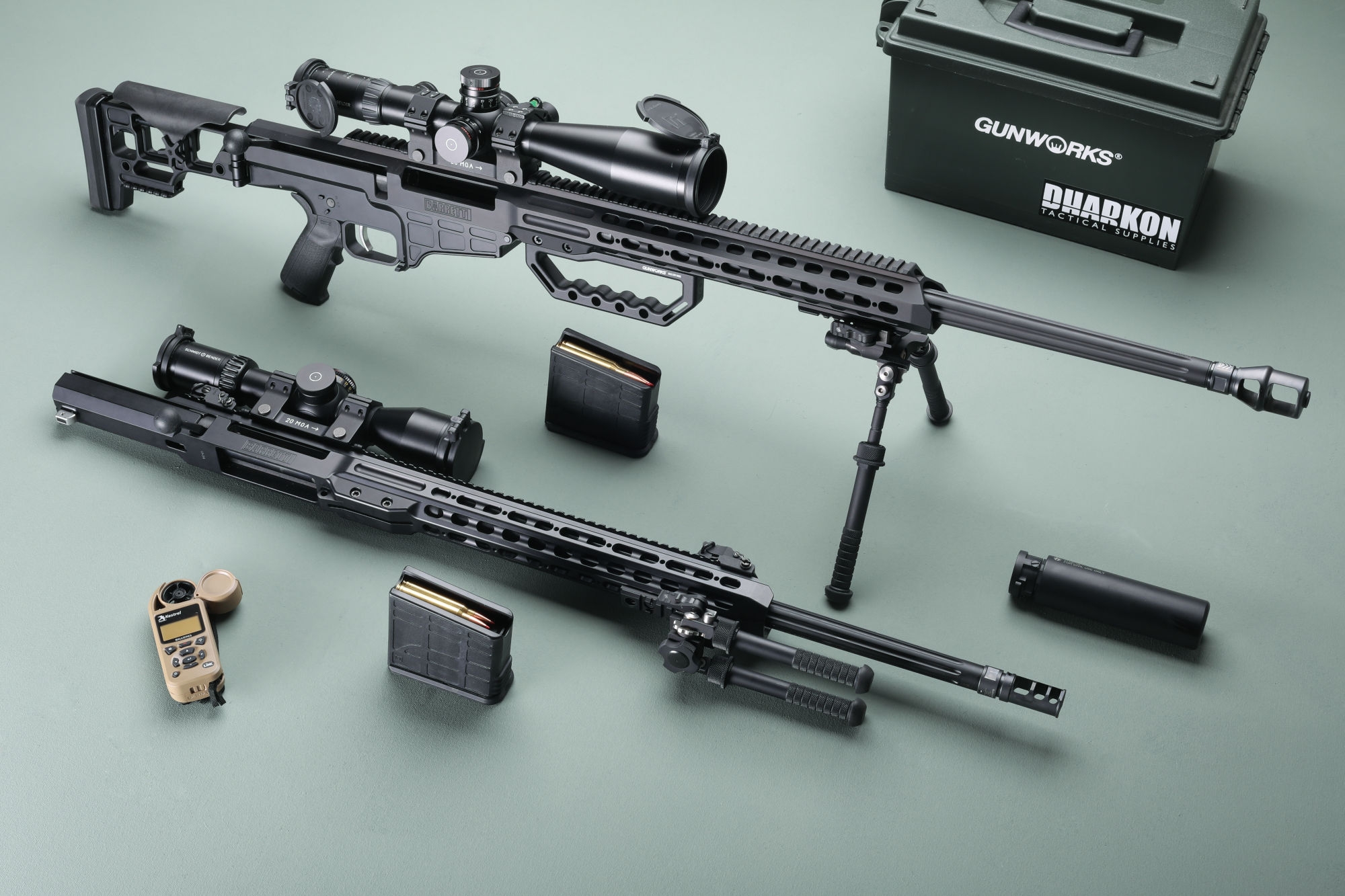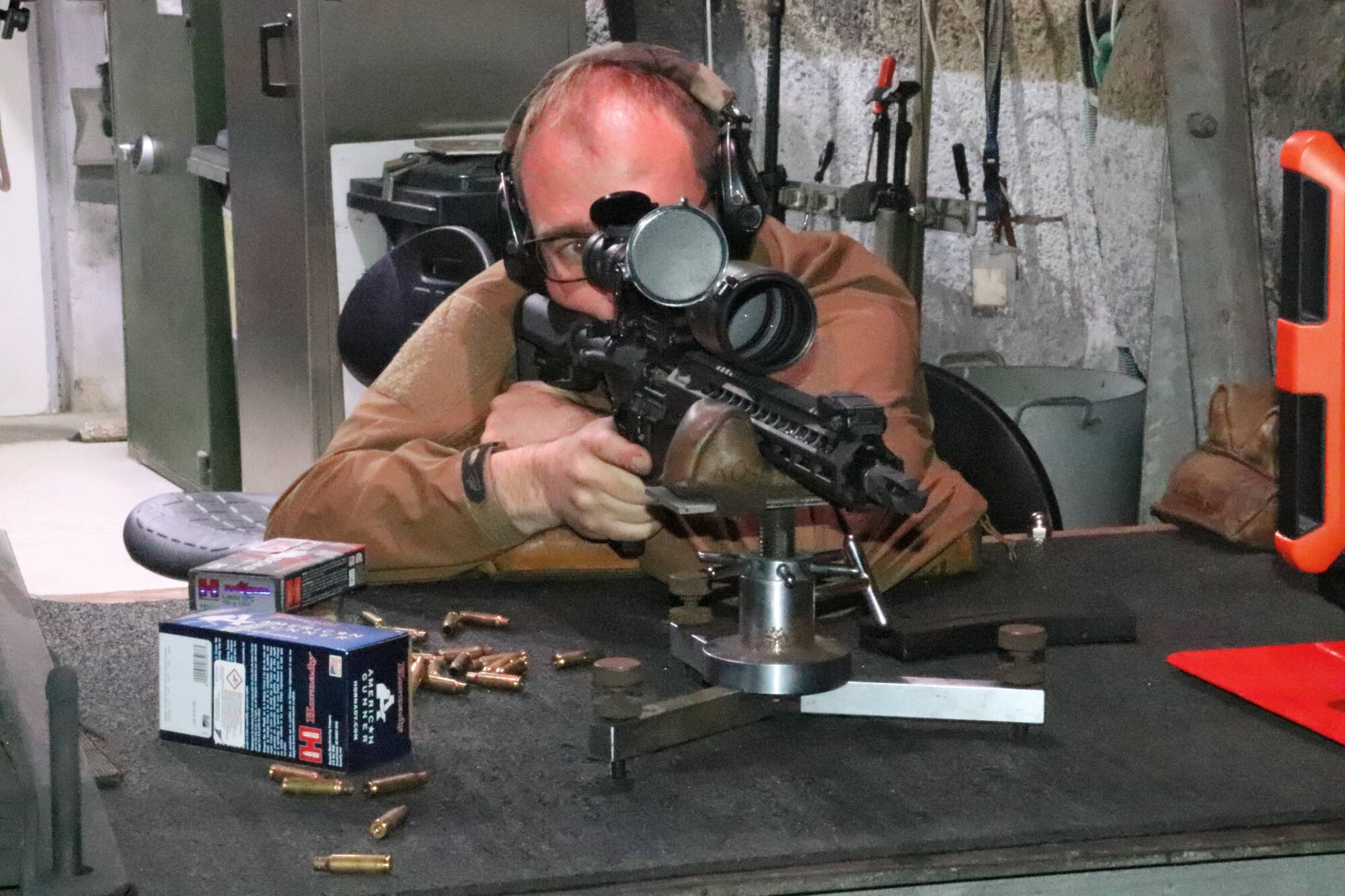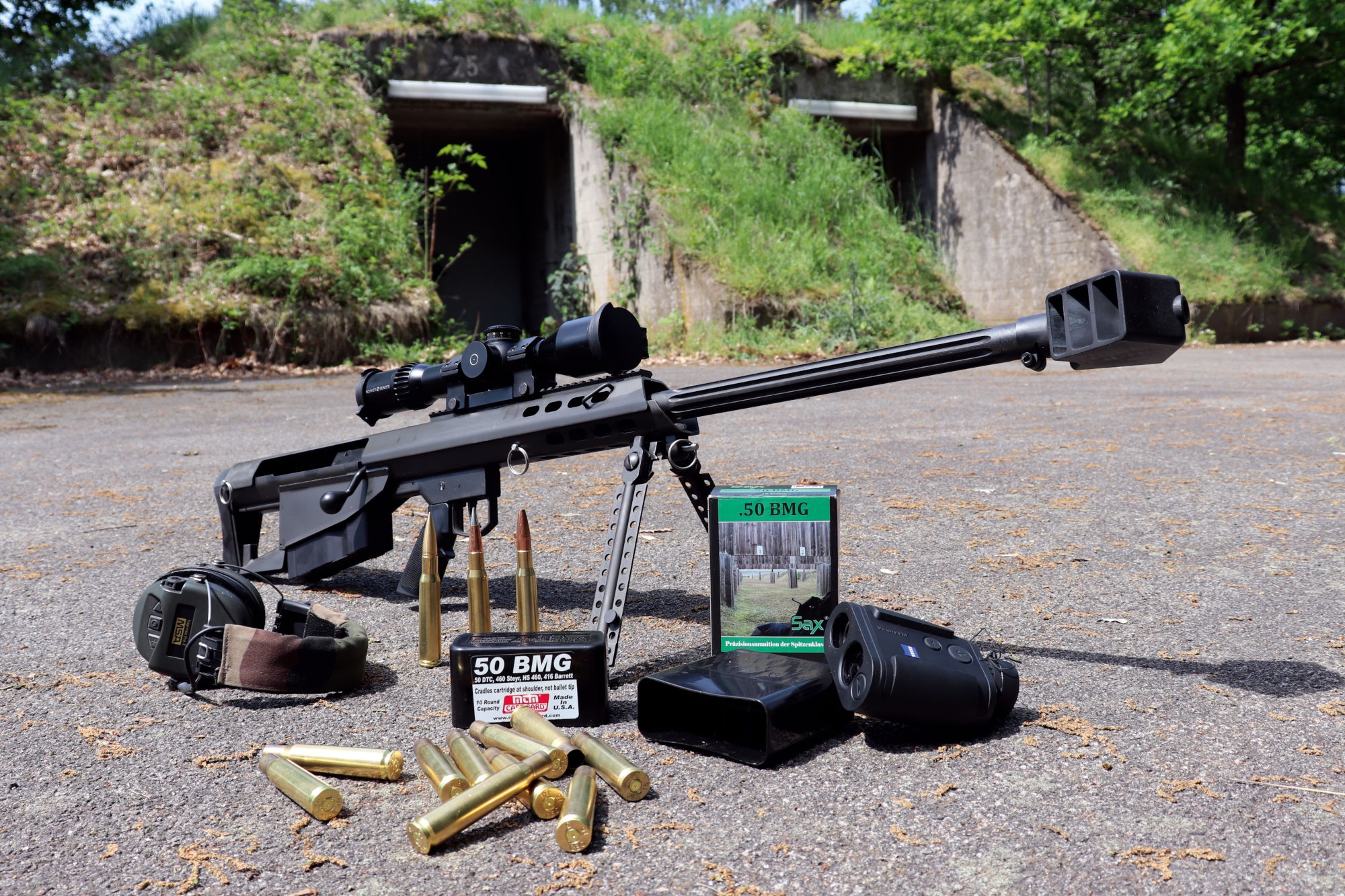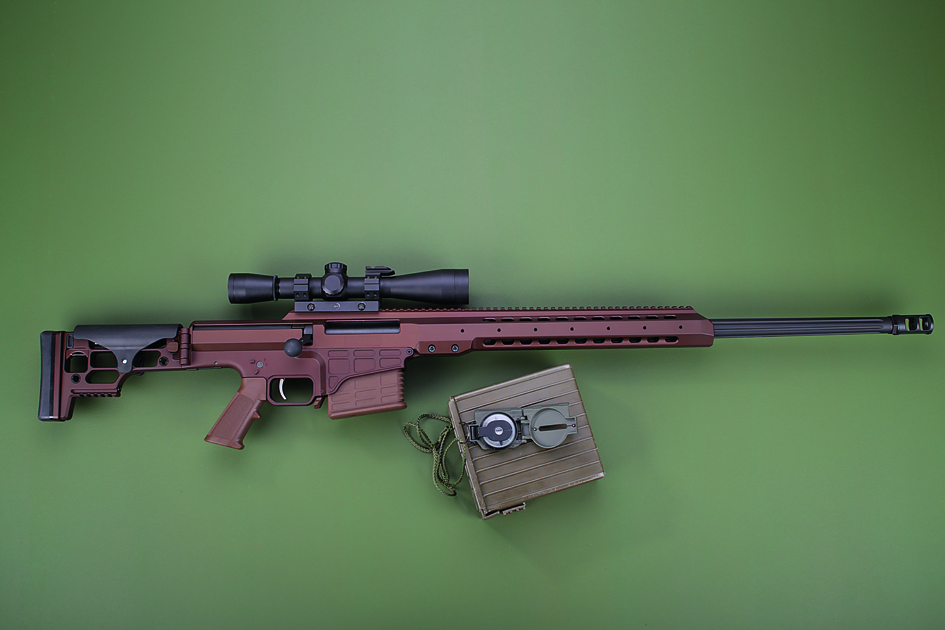Article also available in other languages

Ever since the German army has introduced the 50er sniper rifle M 82 of the company Barrett Firearms Manufacturing (www.barret.net) under the designation “G 82“, the name “Barrett“ has come into focus of snipers in Germany. Now, Barett is making a new attempt to meet the strict requirements of USSSOCOM (United States Special Operations Command) for sniper rifles.
The new MRAD is similar in design and structure to the Barrett model 98B, which was presented in 2008. Both models are only available in .338 Lapua Magnum.
However, MRAD has a folding stock and a large range of barrel versions.
Profile
The barrel of MRAD consists of burnished tool steel. The barrels are available in the design “heavy” or “fluted” and in the lengths 20, 24 and 26 inches according to Barrett. In “fluted” design, a 24.5 variant is present in addition to these.
All the interchangeable barrels for MRAD have a 238 mm long swirl, i.e.:
The bullet rotates over a distance of 9.35 inches once around its longitudinal axis. They are hence specifically designed for heavy bullets (around 300 grains). At their muzzle, there is an inch ¾-20 UNF-thread. This is suitable for the sound absorbers, intended for official use.
In the test weapon, there is a two-chamber muzzle brake on the 688 millimetre long barrel.
Both the vertical impact surfaces of the brake lie at right angle to the bore axis of the barrel. Their through-hole measures 9.5 millimetre and hence 0.9 mm more than the bullet diameter. Based on their shape, the impact surfaces divert the gases not only to the sides but also towards the backside. This counteracts the recoil and reduces it to a considerable extent without causing harm to the shooter. In the test weapon, there is a two-chamber muzzle brake on the 688 millimetre long barrel.
Eight 515 millimetre long flutes in-milled along the firing direction in the casing increase the surface area of the barrel. This provides for better heat transfer and hence rapid cooling of the barrel which becomes hot after firing.
Through the increased radiating surface of the casing, heat shimmer is also observed earlier and the view is worsened. And this happens quickly if up to six grams of nitro powder heat up the barrel after every shot. It has a conical outer contour, i.e.:
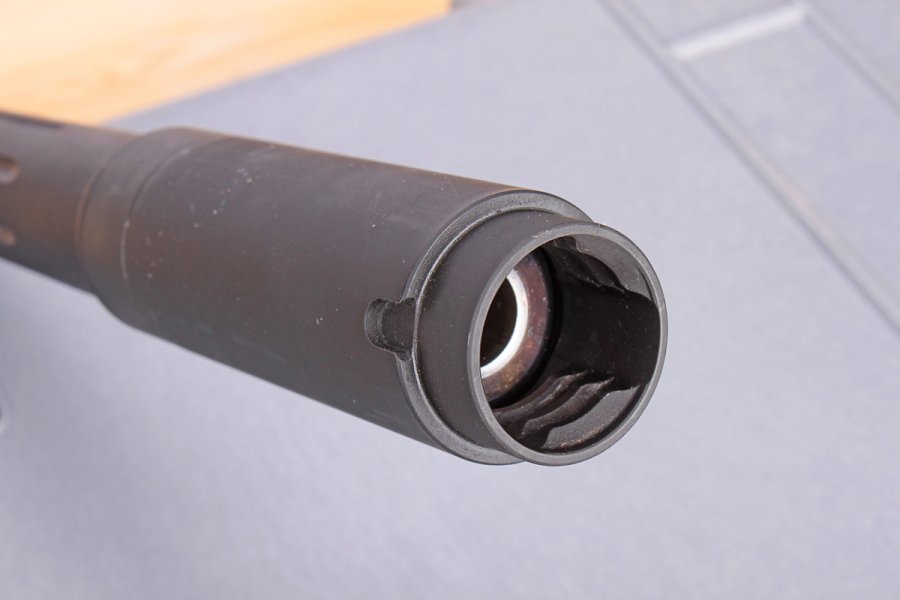
The barrel diameter tapers from 31.8 millimetres at the root to a 23.4 mm at the muzzle. A connector is screwed to the barrel for the locking lugs. And the 3190 grams heavy barrel is supported in the entire system against the coating surface of the connector.
The stock consists of high-strength aluminium alloy. Its surface has a chocolate-coloured hard-anodised surface for protection against scratches and tear. The customer can choose between black or bronze colour.
The complete stock comprises of three parts: Fore-end with system, hand-grip with integrated trigger system and magazine slot and butt stock. At the fore-end, there is a long ventilate hand protection in octagonal profile design.
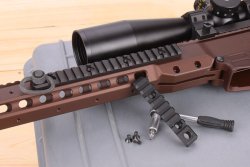
At the sides of the hand protection, there are seven threaded holes and at the lower side, there are six of these. The threads are there for fixing of the Picatinny-Rails (MilStd 1913). Three of these rails are attached to the weapon as standard. Besides the typical transverse grooves, the rails also have a hole for quick-change sling swivel studs.
The topside of the fore-end forms a continuous 550 mm long Picatinny-rail. In order to exploit the vertical adjustment range of the riflescope and hence the range of the .338 Lapua Magnum cartridge, Barrett has a rail with tilt of 30 angular minutes (MOA = Minute of Angle).
The positive thing is that Barrett has rails and fore-end made from a single block. In this way, the source of error is eliminated: There are no rail nuts here that can loosen up at some time.
At the centre of the fore-end, the slot for the barrel is located. As in case of most of the weapons with interchangeable barrel option, Barrett also relies on clamp fastening in MRAD. In order to ensure the correct position of the barrel, there is a semi-circular notch at the topside of the connector.
The system has a centering spigot as counterpart. This eliminates the radial internal clearance and rules out the possibility of twisting of the barrel when locking. A flange in the system and a corresponding turned down surface at the bearing bushing regulate the insertion depth.
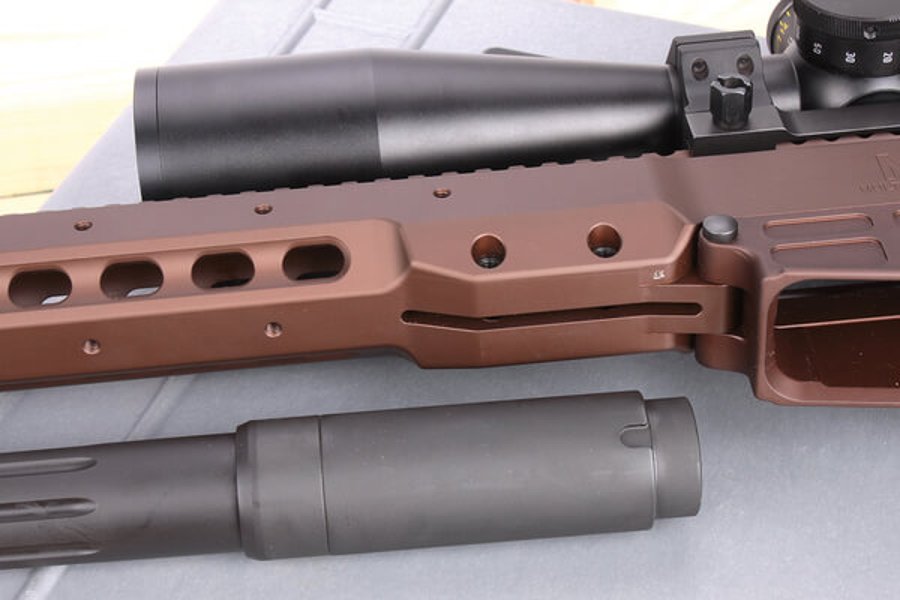
Two T-30 torx screws at the right weapon side clamp the barrel in the system. After loosening the screws, the barrel can be taken out from the front. It is quite easy to change the barrel and it can be done within a minute with the hand. It is recommendable to set the rifle to the butt plate. This prevents tilting over during removal and insertion of the barrel. The barrel which is similar to a long lever arm could bend otherwise.
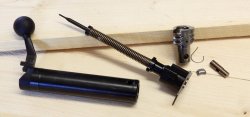
The locking of MRAD takes place in two plastic inserts in the system. These consist of highly impact-resistant glass fibre-enforced polyamide manufactured in injection moulding procedure. According to the manufacturer, both the inserts serve as dust protection and help guide the chambers.
The locking of the test weapon takes place without tilting. However, a noise is generated which reminds of the friction between rough polyester materials rather than moving weapon parts.
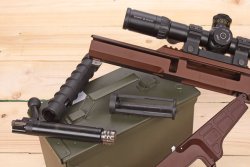
A hinge pin connects the system casing (Upper Receiver) and grip (Lower Receiver). The pressing of a poorly accessible catch just behind the pistol handle loosens the connection between the upper and lower receiver. When unlocked, both the parts open up as a hinge over the hinge pin. The lock has to be opened up first of all however. Otherwise, the back plastic insert ruins the process.
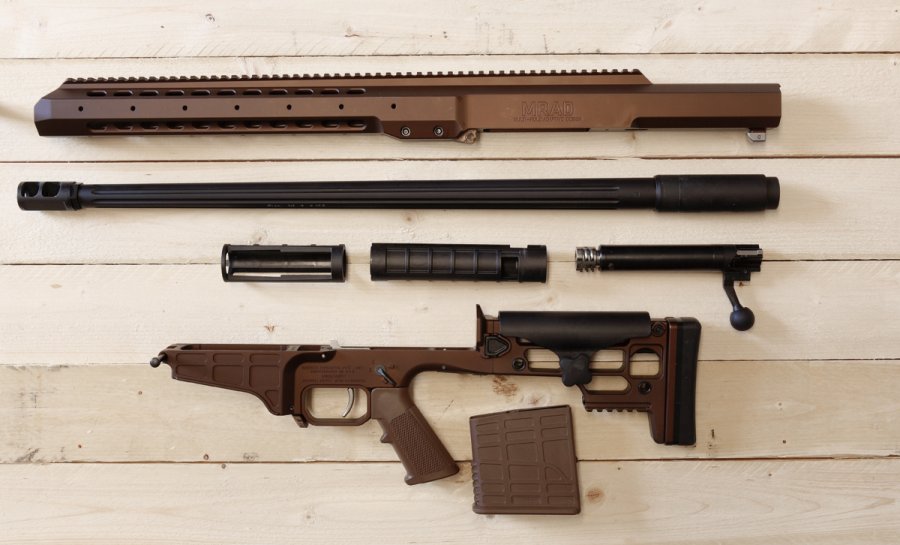
The magazine slot holds a ten-bullet (two-row) plastic magazine. According to the US military regulations for sniper rifles, the magazine must fall down freely from the weapon upon pressing the magazine opener. While the shooter loosens the lock with one hand, he can already hold the new magazine in the other hand and hence insert it quickly.
The trigger can be adjusted but the shooter has to leave the grip for it first of all. For this, one can rotate the safety lever between the “F“- and “S“-position. Then one can press this lever with a cartridge tip from the right side. The trigger can be taken out from the back topside.
For adjusting the trigger resistance and the first stage, one can loosen a lock nut and adjust the mechanical system using an Allen wrench.
The grip has a M 4-/M 16- compatible interface allowing almost all pistol grips to be fitted for this weapon. The standard mounted specimen is hollow but extremely stable and stiff. Fish skin at the sides and grooves at the backside of the pistol grip provide for safe hold. The butt stock is pinned with a hinge pin with the casing. The pin serves as a hinge at the same time for the folding stock.
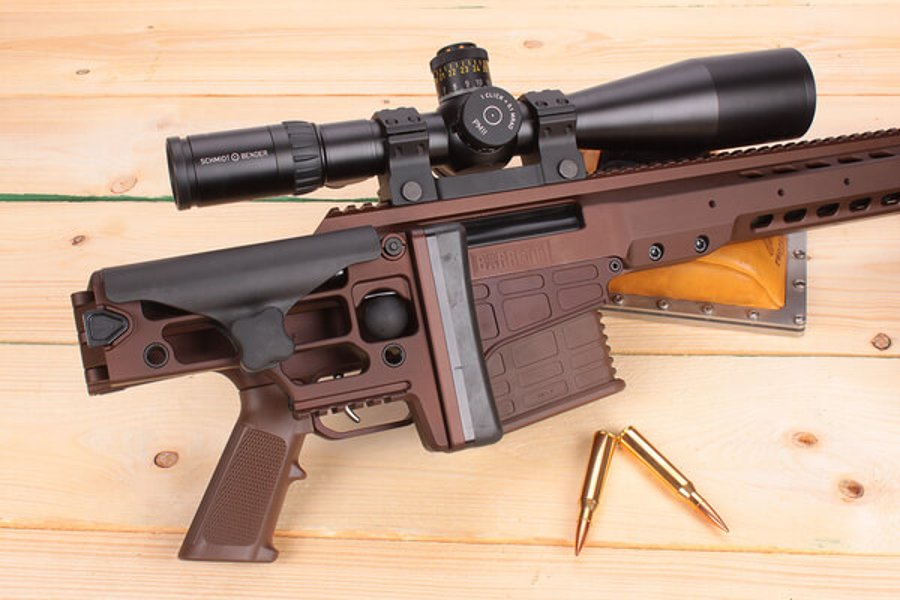
After pressing the U-shaped button on the left piston side, the left shoulder support can be folded at the right side of the casing. The weapon’s length is reduced from 1258 to 1055 millimetres here.
The rubberised bullet of the bolt handle takes over the lock in the process.
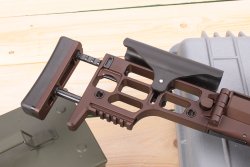
The buttstock offers two adjustment options. Through loosening of a screw covered with rubber, the height of the cheek piece can be adjusted continuously by 31 mm in an elongated hole guide. At the lower side of the butt stock, there is a five centimetre long Picatinny-rail.
The stock length can be adjusted by 40 millimetres in four steps. The push-button required for this is present at the top left of the stock end. The end part is formed by a soft rubber butt plate.
The lock built completely out of steel weighs 478 grams. Like the barrel, the locking head can also be removed for change of calibre.
Until now, Barrett has offered MRAD only in .338 Lapua Magnum. One might want to keep other options open through this such as interchangeable barrels in .300 Winchester Magnum or .308 Winchester.
At the shooting range
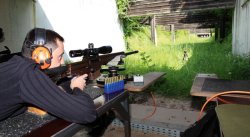
Before the first fire, chemical barrel cleaning took place with Robla Solo Mil and Robla Solo Force. Since the 338er barrel was new, the testers underwent the usual procedure.
After 50 bullets had gone through the barrel, the actual precision test began: At the shooting range in Philippsburg, 100 and 300 metres distance were part of the program.
At a troops training place, it was possible to shoot from a distance of up to 1400 metres a couple of days later. The target included distances of 1000, 1200 and 1400 metres. The plan was to compare the four fillings with each other with respect to their precision over a one kilometre distance.
Unfortunately, the weather upset the plans here. With all these fillings, a 30 times 30 centimetre large target could be held at 1000 metres but the changing wind directions and intensity and the rains did not allow for reproducible results of the shots.
At 1200 and 1400 metres, reading the wind properly could also play a very important role. However, it can be difficult to do so even with some experience. The bullet flight path was quite complicated at these distances over a small valley. Here, the wind directions on ground and some metres above the ground were completely different.
Hence, it appears to make less sense to publish the results. Hence, the testers avoided to provide their details and concentrated on shorter distances from which one can shoot under good weather conditions.
The scatter group diameter ranging from 20 millimetres to 100 metres is a fair average for the .338 Lapua. The bullet requires around 150 to 200 metres in order to be stabilised properly. Hence, the results on the 300 meter path are clearly more significant than the results with short distances. The fillings of MEN and Hornady were surprising in the positive sense. Both these cartridge types had groups of around 25 millimetre diameter. This is an excellent result for fabric fillings in .338 Lapua.
The trigger of MRAD can neither be classified in the category of action point nor direct triggers. Its first stage is around three millimetres with an almost constant trigger weight. It breaks without noticeable pressure point. The testers quickly found their way however and the shooting results prove the good characteristics of the trigger. Even with full magazine, the lock worked well and reliably.
The cartridge insertion shall, however, always take place from the magazine in case of MRAD. Separately inserted cartridges are usually not fed properly by the chamber since the bullet tip blocks the path from the side at the barrel. Due to lack of a two-leg rack and ground spade, the testers shot from a two-part STL benchrest area.
The recoil was quite comfortable for strong calibre. The muzzle brake clearly reduces the recoil impulse and guides the combustion gases away from the shooter. A large series of shots would not be problem if the air above the barrel did not begin to flicker after five to ten shots.
Even after a total of 120 shots and five hours of rain, the rifle did not show any weaknesses and worked flawlessly.
Technical Data of the BARRETT MRAD in .338 Lapua Magnum

| Model: | BARRETT MRAD |
| Price: | € 7.900,- |
| Caliber: | .338 Lapua Magnum |
| Capacity: | 10 + 1 Rounds |
| Barrel Length: | 688 mm |
| Barrel Profile and Twist: | 5 Grooves, right / 1: 238 mm |
| Length: | 1.055 mm* / 1.258 mm |
| Trigger Pull: | 1.370 g |
| Weight: | 6.850 g (without Scope and scopemount) |
The MRAD came with the following Features: Bolt Action with nine Locking Lugs, canelured Barrel, Muzzle Brake and Folding Stock. Spare Magazines and a Pelicase are included.
*with folded Stock
BARRETT MRAD in .338 Lapua Magnum
Nr. | Factory Ammuniton | V3 (m/s) | E3 (J) | SK 100 (mm) | SK 300 (mm) |
| 1 | 250 grs (16,2 g) Lapua Scenar | 909 | 6693 | 21 | 53 |
| 2 | 250 grs (16,2 g) MEN Sniper Line Match | 860 | 5991 | 27 | 52 |
| 3 | 250 grs (16,2 g) RWS Target Elite Plus | 886 | 6358 | 22 | 42 |
| 4 | 285 grs (18,5 g) Hornady Match BTHP | 888 | 7294 | 23 | 33 |
Annotations/Acronyms:
SK 100 (mm) = Group in Millimeters on 100 Meter Distance,
five shot group from a benchrest rest.
SK 300 (mm) = Group in Millimeters on 100 Meter Distance, five shot group from a benchrest rest.
V3 = Velocity of the bullet measured in 3 Metrs distance with a MEHL BMC 18.
E3 = Energy in Joules
BT = Boattail HP= Hollow Point
Conclusion
In form of the Barrett MRAD, the purchaser can obtain a very good and widely used precision rifle with an outstanding high-tech look.
The foldable buttstock of MRAD offers adequate adjustment options and the muzzle brake minimises the recoil effectively.
The trigger’s characteristics might be slightly unconventional but it certainly delivered some good shooting results.
Enthusiastic shooters should add a 26"-barrel to the weapon. Magnum cartridges optimally require such long barrels for developing energy.
What would still lack is a stable ground spade, a Picatinny-rail for its insertion is already present at the stock. The price is fixed at € 7,900.- no cheaper fun.
Text: Christopher Hocke and Andreas Wilhelmus Photos: Michael Schippers and Christopher Hocke The test weapon came from The Duke, the riflescope from Schmidt and Bender, the assembly from Recknagel. Lapua, Helmut Hofmann, RUAG Ammotec and MEN contributed the ammunition for this test. Thank you very much! Shooting test



